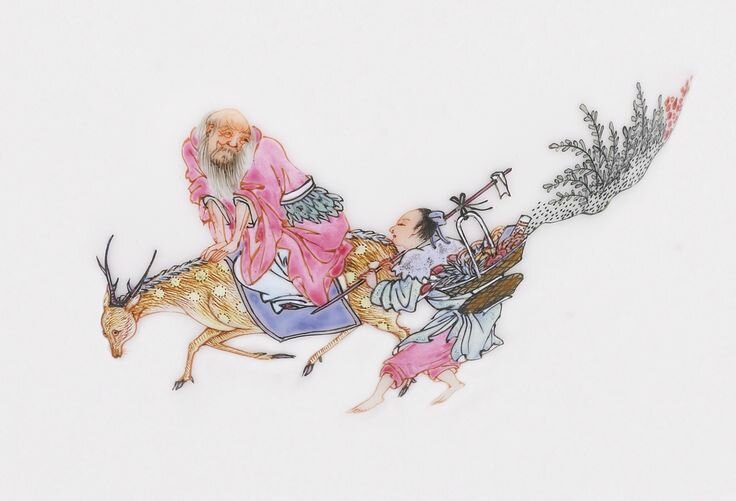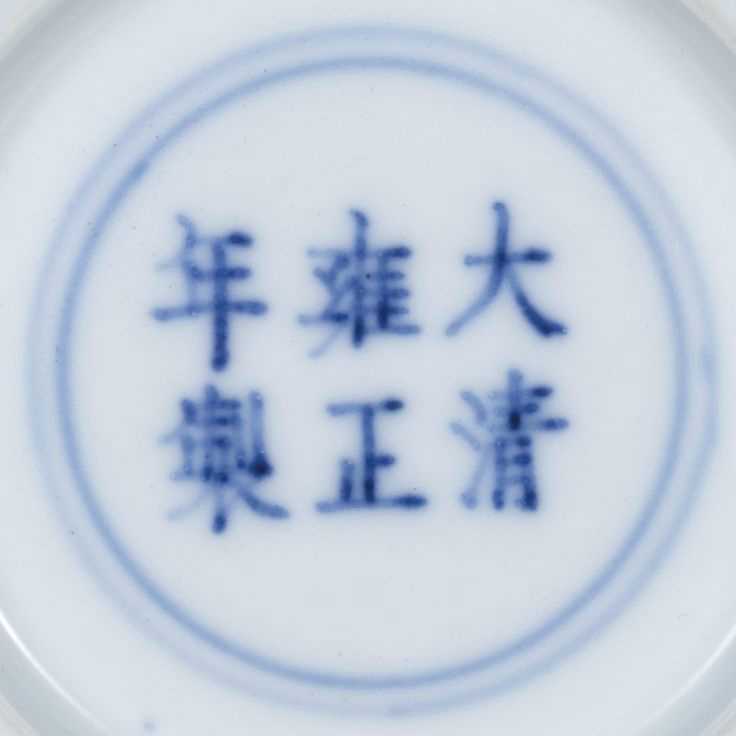A superbly painted and extremely rare famille-rose 'Immortal' bowl, Mark and period of Yongzheng
Lot 3635. A superbly painted and extremely rare famille-rose 'Immortal' bowl, Mark and period of Yongzheng (1723-1735); 10 cm., 4 in. Estimate 5,000,000 — 7,000,000 HKD (574,780 — 804,692 EUR). Lot sold 7,520,000 HKD (864,469 EUR). Photo: Sotheby's
delicately potted with gently curved sides supported on a short footring, the exterior meticulously painted with Shoulao in long rosy-pink robes secured by a leafy belt, riding on a caparisoned deer with branched antlers, accompanied by an attendant carrying a basket of flowers and lingzhi amongst other treasures with a long hoe, all against a grassy sloped landscape leading to a craggy rock amidst further bushes, the base inscribed with a three-column six-character reign mark in underglaze blue within a double-circle.
Provenance: A private family collection, Guernsey, formed in the 1930s, by repute.
Martel Maides Auctions, 29th November 2009, lot 110.
Note: Delicately painted with a charming scene of the immortal Shoulao riding a deer whilst interacting with his attendant, this bowl is an extremely rare example of famille-rose from the early Yongzheng period. The new development of enamelling is evident in the pink robes, with the density of the medium apparent in its thick application and slight transparency. Carefully outlined in iron-red, the soft elderly features of Shoulao endow him with an air of gentle kindness which contrasts with the youthfulness of the attendant. The deer, with its meticulously detailed fur coat, and the leafy belt tied around Shoulao symbolise longevity and his divine nature respectively.
Figural designs were relatively uncommon during the Yongzheng reign, and when employed, they were subtle, unassuming scenes set against a plain background in keeping with the elegant restraint characteristic of the Yongzheng period. Designs were also placed on a white ground to accentuate the fresh palette of colours that was developed initially under the Kangxi Emperor before reaching the height of fencai decoration in the Yongzheng period. The introduction of white enamel by the Jesuit missionaries enabled the Chinese craftsmen to build an extensive palette to create naturalistic, yet idealised, scenes previously unseen in the Chinese repertoire. Compare the style of decoration to a meiping vase decorated with a related scene of an elderly man looking playfully back at a deer, also with a Yongzheng mark arranged in three columns and of the period, published in The Complete Collection of Treasures of the Palace Museum. Porcelains with Cloisonne Enamel Decoration and Famille Rose Decoration, Hong Kong, 1999, pl. 50, together with a vase depicting women playing weiqi and a teapot illustrating a scholar in a garden, pls. 51 and 54 respectively.
The deer on this bowl is reminiscent of 'deer' wine cups created during the Yongzheng reign, which were also inscribed with Yongzheng reign marks in two horizontal lines; see a pair sold in these rooms, 14th November 1989, lot 297; and another pair sold at Christie’s Hong Kong, 1st/3rd May 1994, lot 671, and offered again in our New York rooms, 11th September 2012, lot 14, from the collection of William and Jennifer Shaw.
Sotheby's. Important Chinese Art Hong Kong, 07 Oct 2015

/https%3A%2F%2Fprofilepics.canalblog.com%2Fprofilepics%2F1%2F0%2F100183.jpg)
/https%3A%2F%2Fstorage.canalblog.com%2F03%2F02%2F119589%2F96711876_o.jpg)
/https%3A%2F%2Fstorage.canalblog.com%2F11%2F31%2F119589%2F94773502_o.jpg)
/https%3A%2F%2Fstorage.canalblog.com%2F20%2F83%2F119589%2F94772815_o.jpg)
/https%3A%2F%2Fstorage.canalblog.com%2F26%2F72%2F119589%2F75604929_o.jpg)
/https%3A%2F%2Fstorage.canalblog.com%2F59%2F60%2F119589%2F26458628_o.jpg)






/http%3A%2F%2Fstorage.canalblog.com%2F59%2F39%2F119589%2F129631842_o.jpg)
/http%3A%2F%2Fstorage.canalblog.com%2F77%2F79%2F119589%2F129631259_o.jpg)
/http%3A%2F%2Fstorage.canalblog.com%2F64%2F85%2F119589%2F129631160_o.jpg)
/http%3A%2F%2Fstorage.canalblog.com%2F09%2F41%2F119589%2F129627152_o.jpg)